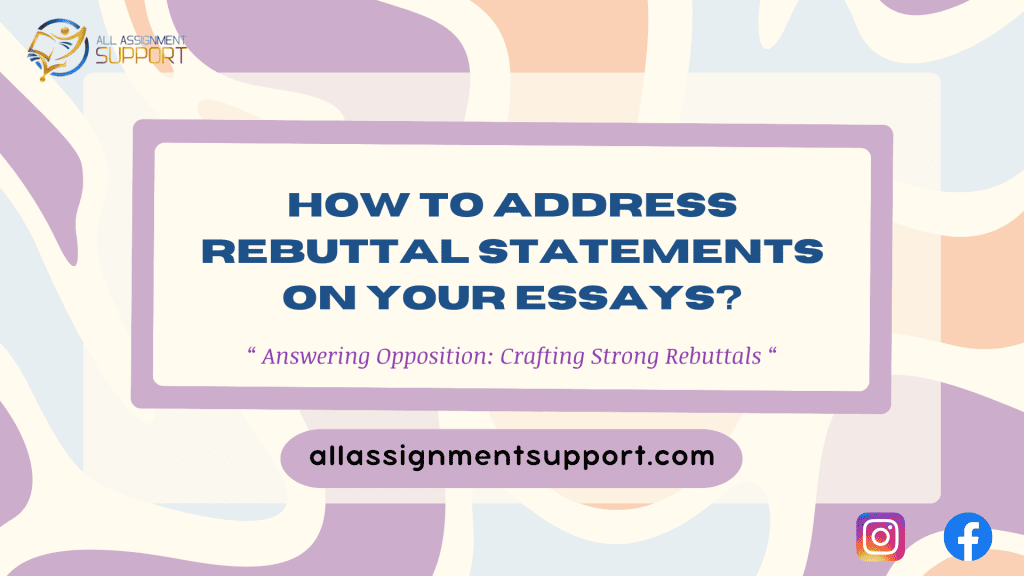Introduction
Why do you add rebuttal statements in an essay? The rebuttal statement is made so that you are able to present your viewpoints effectively for a two-stance opinion essay, agree-disagree essay, or for a highly argumentative essay genre like the Cause and effect essay.
To present two sides of the same coin, you need to logically frame rebuttal statements to present your point of view more comprehensively. Therefore, rebutting is a process wherein you argue over facts or statements that the author has put forth. Say, for instance, you have an agree-disagree essay topic; you may have to agree with what the author has said. Else, you may have to disagree over what the author has said. In this case, how are you going to oppose a point of view and validate the reasons attributed to it?
Here is where you need logically placed rebuttal statements that can invariably come to your rescue. When you frame your rebuttal statements, you acknowledge what the opposite party is saying to you. At the same time, you argue on pointers wherein you may want to differ. This process is carried out via fitting rebuttal statements.
For this to happen, you must master the theme of rebuttal writing. You may have to decipher how to coin rebuttal statements for different types of essays that you plan to write. When you learn to coin good rebuttal sentence examples, it becomes easier for you to put your point across to your audience.
In this guide, we are going to know ‘What is a rebuttal in writing’ on a more descriptive scale.
Importance of Rebuttal paragraphs
In the intro paragraph, we have touched upon the meaning and conceptualization, covering what a rebuttal statement is all about and why we are using it in the first place. Now, let us move on to understand the importance of how rebuttal paragraphs can bring a better meaning and a deeper perspective of ideas you plan to put across the table.
Firstly, students must draft a neat and concise outline for an argumentative essay so that they typically understand where they are supposed to have their rebuttal statements or paragraphs done in the essay. These statements are typically curated to argue from multiple points of view. Finally, the student deduces his conclusive idea by summarizing a portion of their essay.
Secondly, students must create supporting evidence to prove the arguments in their favor. Say, for instance, there is this topic: ‘Uniforms must be banned in schools.’ To what extent do you agree or disagree? Here, the author wants you to either write the essay agreeing with the above point of view or disagree with the same. Therefore, the students must curate argumentative pointers that support or dissect the stance. It is the cleverly coined rebuttal statements that are going to help them with the same.
Thirdly, these rebuttal statements are not just going to help you validate or oppose from a certain point of view. Still, you also have the opportunity to prove why and how your opinion is justified in the truest sense of the word. For the writer to do this craft fully, intelligent argumentative or rebuttal statements have to be used for such paragraphs. Here, you introduce your opposite point of view, then tell the audience why you would feel this way, and finally, provide valid examples or illustrations that prove your point of view.
For most students who attempt this type of essay, curating rebuttal example sentences or statements can be challenging after all. However, with practice and perseverance, students can master the craft of coining compelling rebuttal statements at the bat of an eye!
How do you start refuting?
To be able to refute a particular point of view, you must have a complete understanding of the opposing viewpoints in the first place. Here is a simple three-step process on how you actually learn how to make rebuttal statements and further use them in your essay like that of a pro.
Helping you get started with the same:
1. Knowing your audiences well
You must know who your audiences are. When you analyze or discover who your potential audiences are, you develop a better comfort zone to accept or reject from a particular point of view seamlessly. It would help if you also analyzed which side of the essay point you typically agree with. This understanding is needed for you to curate pointers logically and explain to your audiences why you feel this way.
It would help if you then moved on to understand the position you are in. Arguments or counter-statements can then be coined logically. Sometimes, you have pointers wherein you are not able to claim things in your favor completely. In this case, jot down a rough outline of 5 different pointers on why you refute or agree on a certain point of view. Then, start picking the best 2 of them wherein you can argue, reflect, and effectively validate your points of view.
2. Additional scope for research is on the cards
Having analyzed the position you are on and having decided on the pointers you are going to argue upon, here comes the next penultimate step. You must now start writing the backup points that support your counter-arguments. Here, you deduce logical rebuttal statements that are valid and reasonable from the audience’s point of view, too.
The research process must be taken up so that you do a proper fact-check on why these pointers have to be disapproved in the first place. You must also collect reliable data that support your statements.
3. Effective usage of transition words
While coining rebuttal statements, you may have to argue from multiple points of view to prove your point to your audience invariably. Therefore, you must use connecting words or what is otherwise known as ‘transition words’ to help connect one point of view with that of the other. These transition words or phrases help you connect ideas or arguments on a neat and scaled pedestal.
Using effective transition words, you are able to prove your line of argument more undoubtedly. You also help the readers understand the argumentative statements or rebuttal facts as you keep coining them throughout your essay. These are examples of effective transition words while you deal with an argumentative essay genre. The word lists include:
- But
- However
- Instead of
- On the other hand
- Alternatively
- In contrast with
- It can be argued that
- The problem with this particular scenario is
When you use these transition words effectively in your rebuttal statements, you can easily connect two things that are being compared or contrasted. You are able to show a meaningful relationship between two ideas that are opposite to each other, and you are able to present arguing ideas, one linking the idea to the other. In a nutshell, transition words act as interlinking bridges between two or multiple points of view.
Rebuttal Examples in an Argumentative Essay
Here is an example of how an argumentative essay typically looks like:
Author: Video games are responsible for children’s violent behavior and they take to guns or shooting once they become youth.
You: Here, you want to disagree with this point of view by asserting that violence existed even before video games were invented and you cannot blatantly blame video gaming concepts that instill a certain degree of violence in children.
Here is a rebuttal statement that can help you connect two opposing points of view:
“Some may argue that certain video games include violent scenes that cause children to use guns. Youth violence does appear to be on the rise. However, before video games, there were other courses of violence that children had been exposed to. To blame video games, one would have to ignore the effect of movies, books, music, and other forms of media.”
This is a perfectly poised rebuttal example sentence wherein you connect two opposing points of view but still, you succeed in portraying your points of view in an argument-style essay.
See Also: how to write a hypothesis statement
7 Common Mistakes You Must Avoid While You Try Framing Rebuttal Statements
Here are 7 common mistakes you must typically avoid while you frame argumentative or rebuttal sentence examples. Let us find out what these are:
1. Using a counterargument that is not relevant
It is not an advisable idea to use counterarguments that are irrelevant or illogical. Here is the tip you can use to jot down four to five contracting or rebutting ideas you know of on a rough sheet. You can also jot down the ideas on your digital pad.
Deduce which one of them you can argue, explain, and provide validations on with examples. This way, you can be a little more clear on the pointers you are going to use for your essay typically. Use one of the central ideas for your main paragraph and explain the sub idea under the Sub Main. This is after the Intro paragraph has been done. Therefore, it is the intro followed by the body of content, and finally, you end your essay with a fitting Concluding paragraph.
2. Repeating points already used
You certainly do not want to beat around the bush while you are drawing up high-engaging essays. Therefore, it is always better to have two different ideas and explain them at length. As explained earlier, you jot down your central idea and a sub-idea that is congruent to your main idea.
Following the P-E-E technique, make sure that you do not use a repetitive tone for your essay. Firstly, you introduce the pointer and then explain the same. Above all, provide a suitable illustration or example that substantiates your point of view or your line of argument. When you follow the P-E-E method, you can maintain a neat and uniform sequence without repeating your ideas or statements.
3. Not using transition words
When essay writers do not use transition words, they are not able to connect multiple ideas or points of view under the same cluster. Especially while you deal with argumentative essays, you may have to explain from multiple points of view to validate your verdict or your stance on the essay.
Therefore, you must use transition words to move from one point to another. When you use apt transition words like:
- On the other hand
- Whereas
- Similarly
- Apparently
- But
- To contrast with
Then, it is easier to help audiences navigate from one idea to another. You make the transition process easier and a seamless affair for your readers.
4. Lack of Research
Not using research ideas is not something you are aiming for. The main purpose of rebuttal statements is to give scope for the other person to validate or refer to your point of view. Hence, when you give away your ideas without performing ample research, then the whole purpose of your wanting to present an argumentative paper gets defeated.
You must provide ample citation links and web links where you have taken your resources from. At the same time, if you have taken your ideas or pointers from literacy resources like books or magazines, you can name the author who presented a paper and from whom you derived your inspiration! This way, you provide a fair degree of authenticity, and a cross-check to the ideas and pointers you mentioned in your essay paper.
5. Being emotional
Remember the fact that you are just writing an essay, and writing an essay should not be a matter of life and death. Hence, getting overly- emotional is something writers need not get to. You must aim to logically present your thoughts and ideas in a manner wherein your audiences are able to understand your point of view in a highly objective manner.
You can either approve or disapprove of what the author has said to you in your essay. You do not have to get carried away with your emotions or ideas that may come in the way of you presenting your essay paper sensibly or logically.
6. Poor sentence structuring and grammar
Using poorly constructed sentences or incorrect grammar is, again, a strict no-no while you are cohesively stating rebuttal statements or paragraphs. It would help if you used correct punctuation marks throughout your essay.
Use open and close quotation marks when you want to present a renowned author’s opinion or quote. Use exclamatory marks, semi-colons, or commas as and when needed. This way, you help your audiences gain a correct understanding of your essay type.
7. Using rebuttal statements that are out-of-scope
It would help if you did not use rebuttal statements that are out of scope. You must have a fair understanding of the scope or purpose of your essay genre. Many writers tend to over-argue on their points of view, and the same is done so aggressively that you invariably lean towards taking your line of argument out of scope.
And this is something that must be avoided at any cost. Using clear and concise statements for an argument-style essay must be done within the scope of the essay and not be taken out of the purview of the document.
These are some of the most common mistakes writers make while they are writing their essays for the very first time. Practical tips and ideas have been explained as to how you can avoid these commonly committed errors. Therefore, when you avoid these commonly committed mistakes in essay writing, you can start curating essay topics like a pro!
Concluding Lines to Remember
We have seen several aspects of ‘What is a rebuttal in writing!’ Rebuttal sentence examples have also been illustrated to you for a clearer understanding of what the whole picture looks like.
Practical tips and techniques have been described to new-age writers so that they can perfect their essay writing and eventually become a pro at coining different essay genres in a systematic and streamlined manner.
Do you have trouble with your assignment work, project work, or your thesis? Fret not! All Assignment Support’s dedicated team has renowned Ph.D. scholars who help students systematically perform their assignments and projects, and that too at an affordable price range. Log in to All Assignment Support to learn more about this!
Frequently Asked Questions- FAQs
1. Should you have to coin a rebuttal statement for a synthesis essay?
Answer: Rebuttal statements are not needed for a synthesis essay. The intro and two-sided genres have already been layered up for you by the Author himself.
Say, For example, this is the essay type.
“Describe the advantages and disadvantages of traveling by Metro.”
Here, you are going to describe the pros of traveling by metro train, and you describe the cons following the same. Here, you have nothing to do about performing an interrogation process from your end as the essay has neatly been layered up for you by the Author himself.
2. Which is the type of rebuttal statements you must typically avoid using?
Answer: You can oppose the author’s point of view and coin rebuttal statements. At the same time, you must also respect the author in all its fairness. Using statements that are highly offensive and abusive is what you must avoid while you coin strong rebuttal statements to validate your point of view.
3. Where do you use rebuttal statements?
Answer: You mainly use rebuttal statements for an Agree-disagree essay. Here, this genre of essay is a perfect example of being a highly argumentative essay genre. As the name suggests, you highly agree with the author’s point of view, or you highly disagree with the author’s point of view. Hence, your personalized opinions are validated here. Opinion-style essays also encourage extensive use of rebuttal statements.










